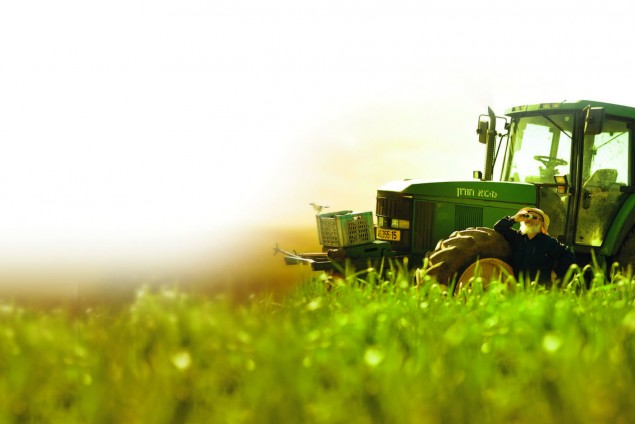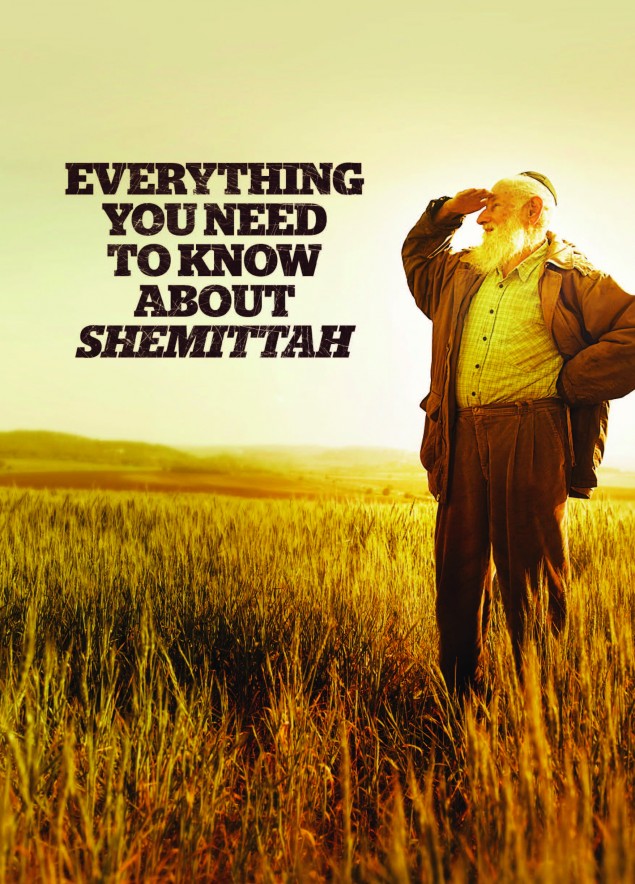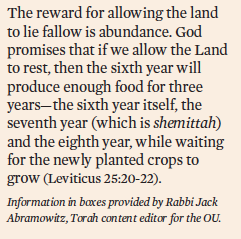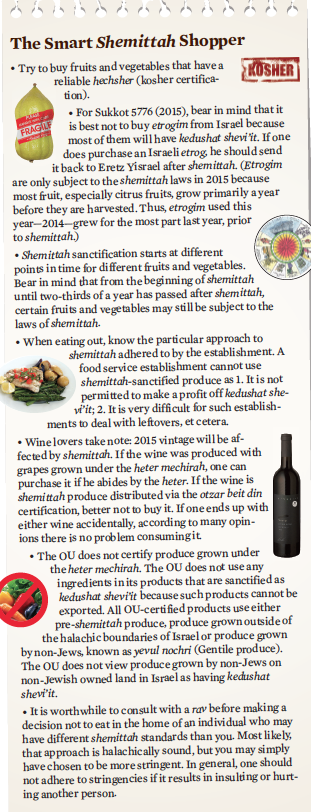Everything You Need To Know About Shemittah
Editor’s Note: This article was adapted from a piece published for the shemittah year in 2014
While shemittah (the Sabbatical year of the land) has unfortunately become a hot political topic in modern-day Israel, it is important to remember that shemittah is actually a mitzvah with its own set of halachot. It is especially vital for the American tourist or student who will be spending the year in Israel learning in yeshivah or seminary to get a firm grasp of the mitzvah and its practical applications.
Which activities are forbidden during the shemittah year?
During shemittah, it is Biblically prohibited for a Jew to sow, plant or prune the produce of the Land as well as to harvest it. The rabbis went a step further and forbade any working of the land as well (such as fertilizing, et cetera). In order to enforce the prohibition against sowing and planting, Chazal forbade the consumption of anything that was sown or planted in the shemittah year. To avoid false claims of incidental sprouting, Chazal also forbade the consumption of all annual plants (i.e., plants that must be planted each year, such as most vegetables) that sprouted during the Sabbatical year, even if they sprouted on their own. Plants that are forbidden to be eaten during shemittah are called sfichin.
Plants that need not be replanted every year (known as perennials), such as trees, take time to mature and do not bear fruit for some time after planting. They therefore are not suspected of having been planted during shemittah. Thus, fruits that grow during the shemittah year can be consumed as they are not considered sfichin.
Interestingly, while shemittah is a Biblical commandment, nowadays (according to most opinions, including that of the Shulchan Aruch), it is considered a rabbinic mitzvah. The Biblical obligation is only in effect when a majority of the Jewish people live in the Land of Israel. Additionally, some authorities are of the opinion that shemittah only has the status of a Biblical commandment when there is a functioning Sanhedrin, authoritative court in Jerusalem.
Which activities are permitted during shemittah?
As mentioned above, the rabbis prohibited any working of the land. Nonetheless, it is permissible to perform activities to save a plant or tree from dying. Therefore, one is permitted to water his lawn. In order to make it obvious that one is watering just to ensure that the grass doesn’t die, he shouldn’t water it frequently. When one does water it, he can use as much water as he would like. One should not, however, use fertilizer, as the purpose of fertilizer is not to keep the grass from dying but to enhance its growth.
While one cannot prune his plants, he can trim them so that they don’t get in the way. One can also mow one’s lawn when the grass gets overly long.
What is kedushat shevi’it?
The Torah mandates that all produce that grows by itself, that is, produce that grows without cultivation during the shemittah year, must be declared ownerless. (This produce is known as “shemittah produce.”) Moreover, anyone can take what he or she needs from another’s shemittah produce. Produce grown on Jewish-owned land during shemittah, intentionally or not, has kedushah (holiness) and is considered kedushat shevi’it. This is because the shemittah year is sanctified to Hashem.
The Torah prohibits harvesting produce during shemittah. Nonetheless, since the Torah tells us that the shemittah produce that we are permitted to consume (the products of perennial plants such as fruits) is l’achlah—to be eaten—one is permitted to harvest enough for oneself and one’s family to eat in the near future. In ancient times, Jews who lived in Eretz Yisrael would actually take advantage of shemittah, and take produce from all the fields and vineyards. Nowadays, however, this benefit of shemittah is nearly obsolete, primarily because most of us live in cities where we rely on retailers to obtain fruits and vegetables. As mentioned, the Torah states that the shemittah produce is to be eaten. The rabbis understood this to mean that we cannot do anything with shemittah produce other than consume it.
How should one obtain fruits and vegetables during the shemittah year?
Since for the modern consumer in Israel going from field to field and picking fruits and vegetables isn’t a realistic option, there are various halachically approved ways to buy produce during the shemittah year. In this article, we will concentrate on the more popular options.
What is heter mechirah?
In the nineteenth century, when Jews began resettling the land in significant numbers, the population was on the verge of starving. Due to the dire situation, many prominent rabbinic leaders endorsed what is known as heter mechirah, which permits the sale of Jewish-owned land to non-Jews for the duration of the shemittah year. According to many opinions, produce grown on land owned by a non-Jew does not have kedushat shevi’it. While this system bypasses many of the hardships posed by shemittah, executing a valid land sale to a non-Jew for a year is no simple matter from a halachic standpoint. Many rabbinic authorities feel that heter mechirah should only be used if there are no other options.
Another concern raised by the heter mechirah is that Jews are not supposed to sell land in Eretz Yisrael to non-Jews (Avodah Zarah 20a). Various heteirim can be applied here. Many believe that while one is not permitted to sell land in Eretz Yisrael to a non-Jew, if the sale ultimately helps yishuv Eretz Yisrael—Jewish settlement in Israel—it is permissible. Another solution endorsed by many rabbinic figures, including Rav Yitzchak Elchanan Spektor, is leasing, instead of selling, the land for a year. It is somewhat unclear, however, if produce grown on land leased to a non-Jew but owned by a Jew has kedushat shevi’it.
Yet another complication is that the farmer not only has to sell the land, he also needs to hire non-Jewish workers to perform the prohibited activities. However, some rabbinic authorities permit Jewish farmers to engage in rabbinically prohibited activities on non-Jewish owned land. Since there are various problems associated with the heter mechirah, many prefer not to rely on it.
What is the otzar beit din system?
While many of the approaches to circumventing the difficulties posed by shemittah are convenient, the majority of them do not afford us the opportunity to eat shemittah produce, which, as we mentioned earlier, is sanctified with kedushat shevi’it. (One should actually relish consuming shemittah produce because it is holy.) What’s unique about the otzar beit din option is that it does provide the opportunity to eat shemittah produce.
Essentially, otzar beit din is a distribution system run by a rabbinic court. Here’s how it works: the beit din hires the farmers themselves as its agents to tend to and harvest the crops. Farmers are hired to engage only in activities that are permitted during the shemittah year, as explained earlier. (Hence, they are allowed to water the trees to ensure that they don’t die and they can pick the fruit. But they cannot fertilize the tree to enhance its growth, for example.)
The beit din appoints middlemen to distribute the produce. While the beit din is not permitted to make a profit off these fruit, it can set a price that will cover the expenses involved in executing the aforementioned, paying the farmers and the middlemen a fee.
This system is an excellent option when properly organized and supervised. Since produce sold in the otzar beit din systems have kedushat shevi’it, special care must be taken to ensure that the farmers do not perform any of the prohibited activities in the fields in order to reap a bountiful harvest. Additionally, prices and selling conditions must be tightly controlled by the beit din.
What is matza menutak?
Kedushat shevi’it and shemittah prohibitions don’t apply to plants that are grown indoors (in pots or containers without holes in the bottom). Consequently, various techniques of mass growing in specially made greenhouses have become another popular way to circumvent the laws of shemittah. Known as matza menutak, literally, detached platform, this technique entails growing produce detached from the ground—such as in hot houses with thick plastic sheeting separating the vegetables from the soil. As this heter is somewhat more complex, it is very important that it be supervised by a reliable rabbi.
Where do the laws of shemittah apply?
The laws of shemittah only apply in halachic Israel. Thus, shemittah isn’t necessarily applicable to all parts of modern-day Israel. Eilat, for example, isn’t part of halachic Israel and therefore one may plant, grow and harvest produce there during shemittah.
Is all produce grown in Eretz Yisrael during the shemittah year regarded as kedushat shevi’it?
Depends. All produce grown on Jewish-owned land in Eretz Yisrael during shemittah qualifies as shemittah produce. Whether or not produce grown on land owned by a non-Jew in Eretz Yisrael has the status of kedushat shevi’it is a matter of controversy. Since many halachic authorities maintain that non-Jewish produce doesn’t have kedushat shevi’it, purchasing non-Jewish produce is another option.
How is one supposed to treat fruit with the status of kedushat shevi’it?
Because of its special status, shemittah produce must be treated with respect. Such produce cannot be wasted. Edible leftovers, including the edible peels of produce such as apples and cucumbers, cannot be discarded. Avocado and kiwi peels, on the other hand, which are inedible, may be discarded. Leftovers that cannot be discarded should be left to rot first and only afterward may they be thrown away. More lenient opinions state that such leftovers can be double wrapped and then thrown away.
Another restriction on shemittah produce is that one cannot cook an item that is usually eaten raw (an orange) or eat an item that is usually cooked in its raw form (a potato). Some halachic authorities allow produce that is often eaten raw but sometimes cooked, like an apple, to be consumed in either form.
It is important to remember that one may not purchase shemittah produce. When shemittah produce is purchased, the money that was used in the transaction attains a sanctified status as well. This “sanctified money” may not be used for any other purchases.
Moreover, shemittah produce cannot be taken out of Eretz Yisrael. That means that if you buy a bottle of otzar beit din wine, it will have the status of kedushat shevi’it. Make sure to drink it in Israel and not bring it home with you to Chutz La’Aretz. (However, if you mistakenly bring it to Chutz La’Aretz, you may still drink it.)
Listen to Rabbi Y. Dov Krakowski discuss the intricacies of shemittah at www.ou.org/life/food/savitsky-krakowski. 
Rabbi Y. Dov Krakowski is rabbinic coordinator for OU Kosher, Israel. He served as rabbi of Kehillas Torah Ve’Chessed in Nachlaot Yerushalayim and currently serves as an official posek in Shaarei Chessed, a neighborhood in Jerusalem.




